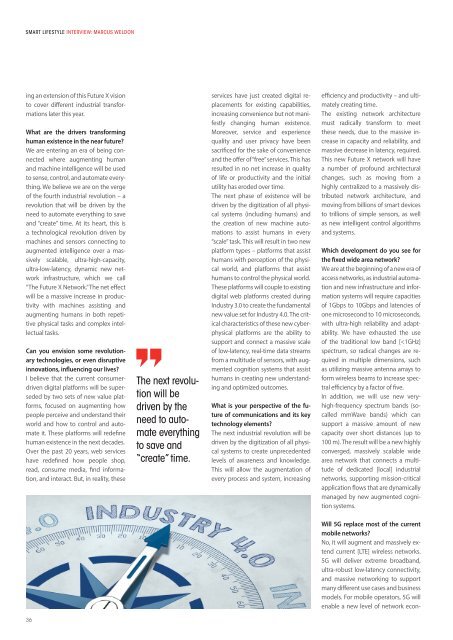Smart Industry 1/2019
Smart Industry 1/2019 - The IoT Business Magazine - powered by Avnet Silica
Smart Industry 1/2019 - The IoT Business Magazine - powered by Avnet Silica
Create successful ePaper yourself
Turn your PDF publications into a flip-book with our unique Google optimized e-Paper software.
<strong>Smart</strong> Lifestyle Interview: Marcus Weldon<br />
ing an extension of this Future X vision<br />
to cover different industrial transformations<br />
later this year.<br />
What are the drivers transforming<br />
human existence in the near future?<br />
We are entering an era of being connected<br />
where augmenting human<br />
and machine intelligence will be used<br />
to sense, control, and automate everything.<br />
We believe we are on the verge<br />
of the fourth industrial revolution – a<br />
revolution that will be driven by the<br />
need to automate everything to save<br />
and “create” time. At its heart, this is<br />
a technological revolution driven by<br />
machines and sensors connecting to<br />
augmented intelligence over a massively<br />
scalable, ultra-high-capacity,<br />
ultra-low-latency, dynamic new network<br />
infrastructure, which we call<br />
“The Future X Network.” The net effect<br />
will be a massive increase in productivity<br />
with machines assisting and<br />
augmenting humans in both repetitive<br />
physical tasks and complex intellectual<br />
tasks.<br />
Can you envision some revolutionary<br />
technologies, or even disruptive<br />
innovations, influencing our lives?<br />
I believe that the current consumerdriven<br />
digital platforms will be superseded<br />
by two sets of new value platforms,<br />
focused on augmenting how<br />
people perceive and understand their<br />
world and how to control and automate<br />
it. These platforms will redefine<br />
human existence in the next decades.<br />
Over the past 20 years, web services<br />
have redefined how people shop,<br />
read, consume media, find information,<br />
and interact. But, in reality, these<br />
The next revolution<br />
will be<br />
driven by the<br />
need to automate<br />
everything<br />
to save and<br />
“create” time.<br />
services have just created digital replacements<br />
for existing capabilities,<br />
increasing convenience but not manifestly<br />
changing human existence.<br />
Moreover, service and experience<br />
quality and user privacy have been<br />
sacrificed for the sake of convenience<br />
and the offer of “free” services. This has<br />
resulted in no net increase in quality<br />
of life or productivity and the initial<br />
utility has eroded over time.<br />
The next phase of existence will be<br />
driven by the digitization of all physical<br />
systems (including humans) and<br />
the creation of new machine automations<br />
to assist humans in every<br />
“scale” task. This will result in two new<br />
platform types – platforms that assist<br />
humans with perception of the physical<br />
world, and platforms that assist<br />
humans to control the physical world.<br />
These platforms will couple to existing<br />
digital web platforms created during<br />
<strong>Industry</strong> 3.0 to create the fundamental<br />
new value set for <strong>Industry</strong> 4.0. The critical<br />
characteristics of these new cyberphysical<br />
platforms are the ability to<br />
support and connect a massive scale<br />
of low-latency, real-time data streams<br />
from a multitude of sensors, with augmented<br />
cognition systems that assist<br />
humans in creating new understanding<br />
and optimized outcomes.<br />
What is your perspective of the future<br />
of communications and its key<br />
technology elements?<br />
The next industrial revolution will be<br />
driven by the digitization of all physical<br />
systems to create unprecedented<br />
levels of awareness and knowledge.<br />
This will allow the augmentation of<br />
every process and system, increasing<br />
efficiency and productivity – and ultimately<br />
creating time.<br />
The existing network architecture<br />
must radically transform to meet<br />
these needs, due to the massive increase<br />
in capacity and reliability, and<br />
massive decrease in latency, required.<br />
This new Future X network will have<br />
a number of profound architectural<br />
changes, such as moving from a<br />
highly centralized to a massively distributed<br />
network architecture, and<br />
moving from billions of smart devices<br />
to trillions of simple sensors, as well<br />
as new intelligent control algorithms<br />
and systems.<br />
Which development do you see for<br />
the fixed wide area network?<br />
We are at the beginning of a new era of<br />
access networks, as industrial automation<br />
and new infrastructure and information<br />
systems will require capacities<br />
of 1Gbps to 10Gbps and latencies of<br />
one microsecond to 10 microseconds,<br />
with ultra-high reliability and adaptability.<br />
We have exhausted the use<br />
of the traditional low band [
















